A HIGH, )ERFORMANCE VAN
Page 40

Page 41

Page 42

If you've noticed an error in this article please click here to report it so we can fix it.
of excellent publicity value
The New Bedford 8-cwt. 12 h.p. Delivery Van Tested With Full Load. Remarkable Power, Brat?. ing and Manceuvrability, also Elegance of Line, Characterize This Interest ing Vehicle
THE extremely good 1: appearance of the new Bedford 8-cwt., 12 h.p. van was apparent from the day it was announced as a new model in this paper (June 16). A further acquaintance with the vehicle, obtained in the course of a full.-day test under load, showed it to have three other important features. These are high power, good brakes and an uncommon manceuvrability.
Appearance with this class of vehicle is of the first importance. Many vans of the type carrying up
B26 .
to 15 cwt. are required by retailers almost as much because of their high publicity value as for the speediness and economy with which they enable deliveries to customers to be effected. A modern van of really smart appearance is in every way suggestive of efficiency; especially when it is driven by a smartly liveried man.
The new Bedford vehicle, with its sweeping contours, its eddy-free windscreen, concealed radiator cap and shapely wings, is undoubtedly one of the best-looking vehicles at present available in its particular class.
Its high power results from tho large engine and the absence of unnecessary weight in chassis and body, the design of which follows. simple lines. The result is that a power-weight ratio of no less than 1.31 b.h.p. per cwt. is obtained, and this, combined with the smoothness of a six-cylindered engine, mounted on rubber, the unobtrusiveness of a silent-third-speed gearbox and the facility of a Synchro-mesh device, which renders impossible a bad change into third or top gear.
The brakes have semi-self-energizing shoes, and the quality of their performance no doubt is due, in the main, to the company's long experience with self-energizing shoes in the larger Bedford models. The simple linkage system also is, in some measure, responsible for the efficiency.
Both the hand lever and the pedal actuate the same set of shoes in drums on all four wheels, and there is a compensation device operating between the front and rear sets. The avoidance of complication in this arrangement shows to advantage in the readings obtained on test.
Small Turning Circles.
Manceuvrability is the benefit obtained from the unusually small turning circles, both of which (left and right) are under 35 ft. in diameter.. This ,advantage is, of course, augmented by the easy gear change, as well as by the convenient arrangement of the controls. 14ut the turning circle is what counts most, because of the frequent need experienced with such a vehicle for turning quickly around in narrow' roadways, carriage drives, etc.
With these introductory remarks upon the leading _performance characteristics, we will now deal with our day's test in the order of events as they occurred.
The chassis placed at our disposal had covered only 75 miles since leaving the assembly line, but it did not appear to be unduly stiff as regards engine bearings, etc., and it certainly had been properly adjusted. Our first test consisted of fuel consumption, and this was made in two out-andhome runs along the same route.
The first run was made with one halt in every mile to simulate the conditions of retailers' deliveries; this is the system we follow with all light delivery vans. The second test was made with only one halt. The result is interesting and unusual in that a better fuel-consumption figure was obtained on the lower-spGed run with 30 halts than was obtained on the higher speed journey. The figures are given in the accompanying panel . and, with due regard to the excellent power and speed, are, of course, satisfactory.
The Zenith do wndraught carburetter was dismantled and found to have the following setting:—Choke, 22 mm.; main jet, 75; compensator, 90; slow-running jet, 55. The speedometer was checked for both speed and distance readings, and a slight correction has been allowed for in every figure quoted.
Turning now to the question of power, our acceleration graph emphatically draws attention to one B27 aspect of it. The acceleration is comparable with that of a first-rate private car, and this, of course, means that in congested urban areas the van need be left behind by no other class of road user. A speed of well over 50 m.p.h. is quickly reached and, whilst this far exceeds the legal speed limit, the figure is important as indicating the power available, not only for acceleration, but also for hill-climbing.
Several hills well known to us were encountered during the day, and we cannot recall having ever made such good ascents of them, except in private motorcars. We took stop-watch readings of certain standard climbs. Cocks Hill, on the Eistree-Barnet road, is 200 yds. long and has a maximum gradient of 1 in 6. Starting from rest, the hill was climbed in second gear at an average speed of 16 m.p.h., which is extremely good.
BrockIey Hill, on the EdgwareElstree road, was climbed from the south side, in which direction it is 440 yds. long and has a maximum gradient of about 1 in 9. Starting from rest, a quick change was made to second gear, in which the speed increased steadily to the crest, where the speedometer showed 27 m.p.h. The time of 42 secs. indicates an average speed of 21.6 m.p.h., which is almost unprecedented for a commercial vehicle—so far as our experience goes.
It was an extremely hot day, the air temperature ate noon being 85 degrees, yet at the end of protracted hill-climbing tests the radiator temperature proved to be only 192 degrees F. this comparing with a figure of 165 degrees, obtained at the end of the non-stop fuel-consumption test.
Excellent Braking Power.
On a gradient of 1 in 6 a restart was easily effected in first gear. On this gradient either foot-brake or hand-brake would easily hold tile vehicle, whether facing uphill or down.
The braking results, shown in thq accompanying graph, are as pleasi ing as the acceleration readings. Either hand or foot application alone could lock all four wheels, so that to test stopping distances with both applications together was pointless.
The springing is most comfortable B2S and is sufficiently light to discourage unscrupulous users from seriously overloading the vehicle. The result is that, with a full 8-cwt. load, cor ners and swerve cannot be taken too quickly. Lovejoy hydraulic single-acting recoil dampers (of Vauxhall manufacture) are fitted at both front and rear.
We made several notes on the body construction, etc. The singlepanel front screen does not open, but there is a scuttle ventilator, as well
as a drop window in each side door. A D-shaped window in each rear door (the two forming an oval) gives a fairly good rearward view for manceuvring. The spare wheel has a quick-release mounting and a neat lock.
The driver's seat has its back-rest built upon a simple tubular frame, which is comfortable and not ungainly; the driver's position is convenient for ingress and egress, the brake and gear levers being on the left. There is an interior lamp mounted over the windscreen, close to the electric windscreen wiper. The dimmer switch for the doublefilament headlamp bulbs is controlled by the left foot. It occurred to us that the inside door handles might be made considerably longer for quick, easy operation. A rational type of bumper is fitted at the front.
The body skirt is, for appearance sake, carried about 7 ins, below the floor level. This makes a neat finish to the rear of the van, but care should be taken to fit a long, not a square, number plate.
Engine and Other Details.
Underneath the bonnet there are several interesting features ; an automatic ignition advance is incorporated in the distributor. The electric light system is arranged in four circuits, the four fuses being in a box in front of the dash; this facilitates tracing a failure. The tools are most conveniently arranged in a box underneath the bonnet. The oil filler is on top of the overhead valve cover. The engine-driven petrol pump is equipped with a filter, as is the down-draught carburetter. A single belt drives the dynamo, fan and the water pump. Manual engagement of the starter before electric contact is made should reduce considerably the wear of starter and flywheel teeth.
Two important lubrication features appealed to us. The first is that a hole in the metal portion of the floorboard gives access to an oil dipstick in the gearbox ; the second is that the back axle can be reached throughe"ar floor trap-door.




























































































